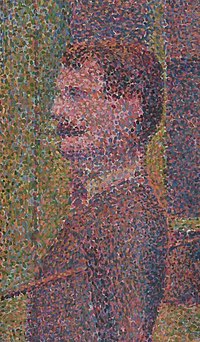Pointillism
From Wikipedia, the free encyclopedia
| This article needs additional citations for verification. Please help improve this article by adding reliable references (ideally, using inline citations). Unsourced material may be challenged and removed. (December 2007) |

Pointillism is a style of painting in which small distinct points of primary colors create the impression of a wide selection of secondary and intermediate colors. Aside from color "mixing" phenomena, there is the simpler graphic phenomenon of depicted imagery emerging from disparate points. Historically, Pointillism has been a figurative mode of executing a painting, as opposed to an abstract modality of expression.
The technique relies on the perceptive ability of the eye and mind of the viewer to mix the color spots into a fuller range of tones and is related closely to Divisionism, a more technical variant of the method. It is a style with few serious practitioners and is notably seen in the works of Seurat, Signac and Cross. The term Pointillism was first coined by art critics in the late 1880s to ridicule the works of these artists and is now used without its earlier mocking connotation.
The practice of Pointillism is in sharp contrast to the more common methods of blending pigments on a palette or using the many commercially available premixed colors. Pointillism is analogous to the four-color CMYK printing process used by some color printers and large presses, Cyan (blue), Magenta (red), Yellow and Black (called "CMYK"). Televisions, computer monitors use a pointillist technique to represent images but with Red, Green, and Blue (RGB) colors.
Neuroplasticity is a key element of observing a pointillistic image. While two individuals will observe the same photons reflecting off a photorealistic image and hitting their retinas, someone whose mind has been primed with the theory of pointillism will see a very different image as the image is interpreted in the visual cortex.[1]
Contents |
[edit] Practice
If red, blue and green light (the additive primaries) are mixed, the result is something close to white light. The brighter effect of pointillist colours could rise from the fact that subtractive mixing is avoided and something closer to the effect of additive mixing is obtained even through pigments.
The painting technique used to perform pointillistic color mixing is at the expense of traditional brushwork which could be used to delineate texture.
Pointillism also refers to a style of 20th-century music composition, used by composers like Anton Webern.
[edit] Notable Artists
- Chuck Close
- Henri-Edmond Cross
- John Roy
- Georges-Pierre Seurat
- Paul Signac
- Maximilien Luce
- Vincent van Gogh also learned and used Pointillism
[edit] See also
[edit] References
- ^ Schwartz, Jeffrey M.; Begley, Sharon (2003). The Mind and the Brain: Neuroplasticity and the Power of Mental Force. Harper Perennial. pp. 337. ISBN 0060988479.
|
||||||||||||||
|
|||||||||||||||||||||||

